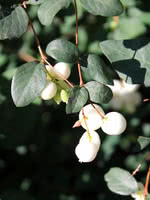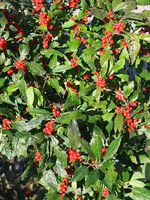Mon-Fri 9am - 5pm Mountain time
Western Snowberry vs Winterberry
Symphoricarpos occidentalis
Ilex verticillata
NOT AVAILABLE THIS SEASON - MIGHT RETURN
CUSTOM GROW
Like the Common Snowberry, the Western Snowberry is a small shrub with pink flowers useful for feeding livestock and preventing erosion. Unlike the common species, however, the Western Snowberry is much more suited to wet conditions, capable of persevering through poor soil drainage and occasional flooding.
After the Snowberry's flowers have bloomed, it produces berries which often last on the plant through winter. These berries are toxic to humans, but livestock and local wildlife love them! Those hoping to attract wildlife to their property can plant Snowberry and expect to see animals foraging on it much later in the year than other plants.
Winterberry is a small shrub that produces large quantities of bright red berries that remain on the plant through the fall and into the winter. Adding this shrub to your yard will give it a unique splash of color and attract birds, especially after the leaves drop.
Note: although the foliage is attractive on its own, you need at least one male plant near your female plants or they won't produce berries.
Western Snowberry Quick Facts
Winterberry Quick Facts
Toxicity: berries are toxic to humans

